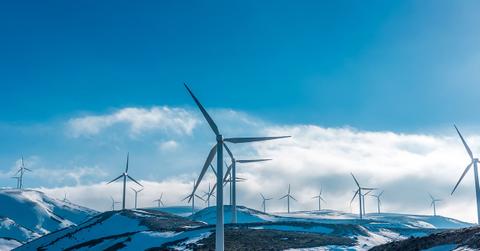Google Reaches 100% Renewable Energy Goal By End Of 2017
One year ago, Google announced it would hit a goal to run its data centers and offices off 100-percent renewable energy by the end of 2017. After adding three more wind farms in the US, the company has officially reached its mark .
Updated Nov. 19 2020, 9:41 p.m. ET
Google has reached its goal to run on 100-percent renewable energy by the end of this year. Sealing the deal was the company's move to sign onto three wind-generated power plants, which boost Google's operating capacity up to three gigawatts. The landmark achievement continues a trend of tech giants diving into the renewable energy industry.
Contracts for the additional 535 megawatts of capacity came from two 98-megawatt wind plants in South Dakota, a 200-megawatt wind farm in Iowa, and a 138-megawatt plant in Oklahoma, according to Sam Arons, senior leader at Google's Energy and Infrastructure division.
More than $3.5 billion worth of investments have been put into the renewable energy infrastructure for Google. The lion's share of that money was put into solar and wind-powered energy sources, as those prices have dropped significantly; by as much as 60 to 80 percent.
The investments have ensured no interruption in Google's products and services while completely eliminating the need for fossil fuels.
“With solar and wind declining dramatically in cost and propelling significant employment growth, the transition to clean energy is driving unprecedented economic opportunity and doing so faster than we ever anticipated,” Gary Demasi, Google’s global infrastructure director, said in a company statement.
Google announced its target date operating at 100-percent off renewable energy in a blog post last December by Urs Holzle, senior VP of the technical infrastructure. At the time, the company had already purchased 20 different renewable energy sources around the world. Two-thirds of them are in the United States, and the company reports already seeing a return of “tens of millions of dollars” annually to property owners and the government.
While Google’s engineers have been able to improve the efficiency of data centers and office programs -- up to 50 percent less energy being utilized -- they continue looking for ways to help the company cut down on its carbon footprint. Holzle noted that by switching over to renewable energy, Google had a more stable price to pay for power as traditional methods will inevitably cost more in the future.
Google’s investments will help the communities that host the renewable energy sources, as well. Avangrid, who operates the wind farms in South Dakota, said the economy would improve from the influx of jobs to rural areas there. While Google’s power would still be coming from the grid, renewable energy credits will be matched to what’s generated from the source in order to reach the company's target.
Other corporate giants have stepped into the renewable energy market, as well. Apple recently launched a store that’s completely powered by renewable energy, and is pushing to get operations at that level. Amazon has installed a 253-megawatt wind farm in Scurry County, Texas, to help operations become 100-percent renewable. Striving to reach half that mark by the end of 2017, Amazon is well on its way with four wind farms located in Indiana, North Carolina, and Ohio.
